Difference between revisions of "Condor folders"
Rebollo fr (talk | contribs) (McK source) |
Hanskerensky (talk | contribs) m (→Actual examples: Refined Link URL) |
||
| (59 intermediate revisions by 7 users not shown) | |||
| Line 1: | Line 1: | ||
| − | {{Japanese Semi | + | {{Japanese Semi prewar and Six prewar}} |
| − | |||
| − | + | The '''Condor''' is a series of Japanese 4.5×6 and 6×6 folders, made from 1939 by [[Condor Camera|Motodori]],<REF> Date: advertisements and articles listed in {{Kokusan}}, pp.336–7. Attribution to Motodori: {{Kakaku1141_short}}. {{MK}} attributes a "New Semi Condor" to "Nissan Kogaku" (p.738), a company whose relationship to Motodori is unclear, and a "Condor" folder to [[Neumann & Heilemann]] (p.717), the latter because of a confusion with the maker of the shutter. </REF> and successors of the [[Victor folders]]. | |
| − | == Semi Condor and | + | == General description == |
| + | All the Condor folders share the same body, inherited from the [[Victor folders|Semi Victor and Victor Six]] and copied from the large [[Baldax]] model. They have a folding optical finder, whose front part folds above the rear part. The folding bed release is to the right of the viewfinder, as seen by the photographer holding the camera horizontally, and there is a body release on the left. The advance knob is at the bottom right. The back is hinged to the left. It seems that all models have a single red window to control film advance (see [[#The 17 exposure and 13 exposure feature|below]]), situated at the bottom left of the back and protected by a vertically sliding cover. This single red window is the only visible difference between the early Condor models and the preceding [[Victor folders]]. | ||
| − | The | + | The name is embossed in the front leather: ''Condor'' on the 4.5×6cm models and ''Condor-Six'' on the 6×6cm models. All the Condor models have a front-cell focusing Delter Anastigmat lens, except maybe the very last ones. |
| − | + | == Evolution == | |
| + | === Introduction of the Semi Condor and Condor Six === | ||
| + | In 1939, the 4.5×6 '''Semi Condor''' (セミコンドル) and 6×6 '''Condor Six''' (コンドルシックス) replaced the Semi Victor and Victor Six. They were both featured in the new product column of the May 1939 issue of {{ACA}}.<REF> {{Kokusan}}, pp.336–7. </REF>. They have a handle at the right end of the body, covering the back latch, and the back itself is opened by a small button situated behind. The Condor Six exists in two versions: one has red window advance like the Semi Condor and is called the '''ordinary model''' (普及型), whereas the other has an auto-stop film advance device and an exposure counter. This mechanism was copied on the [[Plaubel]] device mounted on rollfilm backs and on the [[Roll-Op|Roll-Op II]] camera. | ||
| − | + | === Early advertisements === | |
| − | + | Advertisements were placed in {{ACA}} September and October 1939 by [[Nissan|Nissan Kōgaku Kōgyōsha]], a company whose relationship with [[Motodori]] is unclear.<REF> Advertisements reproduced in {{Kokusan}}, p.73. </REF> Three authorized dealers were cited: [[Sanwa|Sanwa Shōkai]], [[Mizuno|Mizuno Shashinki-ten]] and [[Yamamoto Shashinki-ten]]. The Condor were offered with a [[Rulex]] shutter by [[Neumann & Heilemann]], in the following versions: | |
| − | + | {| border="1" cellpadding="4" style="margin: 0.5em 2em; text-align: center; border-collapse: collapse;" | |
| − | + | |- | |
| − | + | | body version || rowspan="2" | Semi Condor || rowspan="2" | Condor Six<br>(ordinary) || rowspan="2" | Condor Six<br>(exposure counter) | |
| − | + | |- | |
| − | + | | lens and shutter | |
| − | + | |- | |
| − | + | | style="text-align:left" | Delter Anastigmat f/4.5,<br>[[Rulex|Rulex B]] || {{yen|70|1939}} || {{yen|72|1939}} || _ | |
| + | |- | ||
| + | | style="text-align:left" | Delter Anastigmat f/4.5,<br>[[Rulex|Rulex A]] || {{yen|78|1939}} || {{yen|80|1939}} || {{yen|86|1939}} | ||
| + | |- | ||
| + | | style="text-align:left" | Delter Anastigmat f/3.5,<br>[[Rulex|Rulex A]] || {{yen|90|1939}} || {{yen|93|1939}} || {{yen|98|1939}} | ||
| + | |} | ||
| + | The shutter speeds are not specified, but a comparison with previous and later versions indicates that the [[Rulex|Rulex B]] has T, B, 5–150 or 200 and the [[Rulex|Rulex A]] has T, B, 1–200 or 250. | ||
| − | + | In November 1939, the Semi Condor was advertised by the distributor [[Sanwa|Sanwa Shōkai]] with the [[Rulex|Rulex A]] (T, B, 1–250) or [[Rulex|Rulex B]] (T, B, 5–150) shutter and the f/4.5 lens.<REF> Advertisement published in {{ACA}}, reproduced in {{Kokusan}}, p.72. </REF> The picture shows a newer type of back latch, consisting of a long sliding bar with no holding strap. The advertisement does not necessarily reflect the full range offered by the maker. The range of speeds for the [[Rulex|Rulex B]] became T, B, 5–200 in a similar advertisement by Sanwa Shōkai dated December 1939, perhaps because the previous one was mistaken.<REF> Advertisement on p.15 of {{NSKT}}, December 15, 1939, reproduced on p.49 of ''Hyaku-gō goto jūkai no kiroku''. </REF> Another December 1939 advertisement by [[Mizuno|Mizuno Shashinki-ten]] lists a fraction of the Semi Condor and Condor Six range, and shows outdated pictures of the camera with the older back latch.<REF> Advertisement on p.22 of {{NSKT}}, December 15, 1939, reproduced on p.56 of ''Hyaku-gō goto jūkai no kiroku''. </REF> | |
| − | + | === The 17 exposure and 13 exposure feature === | |
| + | The Condor models were intermittently advertised as taking 17 exposures per film roll for the 4.5×6 version and 13 exposures for the 6×6. One advertisement dated September 1939 is titled "Red Window Revolution" (赤窓の革命).<REF> Advertisement published in {{ACA}}, reproduced in {{Kokusan}}, p.73. </REF> It says that the Semi Condor was one of the first cameras (at least in Japan) to make use of the '1' to '16' numbers printed in the rollfilm paperback for the 4.5×6 format, whereas at the time other similar cameras had two red windows and were using the '1' to '8' numbers intended for 6×9. The use of only one red window ensures a more regular frame spacing, thus sparing some film. The advertisement says that after taking the 16 exposures it is possible to advance one more frame by hand, without the help of the film numbers, to attain a total of 17 exposures. | ||
| − | + | The explanation about red windows is irrelevant for the 6×6 models, but in the same advertisement the exposure counter of the Condor Six is said to be designed for 13 exposures. This is strange because the advertisement published the month before in the same magazine only said 12 exposures for the Condor Six and 16 for the Semi Condor. It is unknown if the exposure counter was effectively modified or if all this was just marketing nonsense. | |
| − | The | + | The method described was certainly very inconvenient, which is surely why the mention of 17 exposures was abandoned some months later. An advertisement dated August 1940 still mentions 17 exposures but another dated January 1941 says 16.<REF> Advertisements reproduced in {{Kokusan}}, p.72. </REF> |
| − | |||
| − | |||
| − | |||
| − | |||
| − | + | === Documents mentioning the New Semi Condor === | |
| + | The '''New Semi Condor''' (ニューセミコンドル) appeared in mid-1940.<REF> Date: advertisements listed in {{Kokusan}}, p.337. </REF> It has an exposure table added on the back and always has the newer type of back latch. | ||
| − | + | Advertisements dated June and August 1940 and January 1941<REF> Advertisements published in {{ACA}}, reproduced in {{Kokusan}}, p.72. </REF> show the following range of versions: | |
| + | * f/3.5, [[Rulex|Rulex A]], ({{yen|105|1940}} in 1940, {{yen|94|1941}} in 1941); | ||
| + | * f/3.5, [[Rulex|Rulex B]], ({{yen|95|1940}} in 1940, {{yen|85|1941}} in 1941); | ||
| + | * f/4.5, [[Rulex|Rulex A]], ({{yen|88|1940}} in 1940, {{yen|81|1941}} in 1941); | ||
| + | * f/4.5, [[Rulex|Rulex B]], ({{yen|78|1940}} in 1940, {{yen|74|1941}} in 1941). | ||
| + | The June 1940 advertisement was placed by [[Sanwa|Sanwa Shōkai]], the other two mention "Condor Camera Works", certainly a dummy name (see [[Camera Works]]). The top speed of the [[Rulex|Rulex A]] to 1/300 by January 1941. The August 1940 advertisement still mentioned the older Semi Condor in three versions: | ||
| + | * f/3.5, [[Rulex|Rulex A]]; | ||
| + | * f/4.5, [[Rulex|Rulex A]]; | ||
| + | * f/4.5, [[Rulex|Rulex B]]. | ||
| − | + | The official list of set prices compiled in October 1940 and published in January 1941 has many versions of the Condor: "Semi Condor I, II, III, IV" (¥74, ¥85, ¥88 and ¥98), "Condor Six I, II, III" (¥79, ¥89 and ¥110), "New Condor I, II" (¥128 and ¥160), "New Semi Condor I, II, III, IV" (¥74, ¥85, ¥88 and ¥160).<REF> {{Kakaku0141_short}}, type 3, sections 4A, 5A, 6A, 7A, 7B; type 4, sections 3, 5A, 5B, 6A, 6B. </REF> The Semi Condor, Condor Six and New Semi Condor correspond to the advertised models described before. The New Condor is listed among 6×6cm cameras; it is otherwise unknown. | |
| − | + | The New Semi Condor with 1–300 shutter speeds was sometimes offered as the '''New Semi Condor III''', with f/4.5 or f/3.5 lens. This name appears for example in an advertisement dated May 1941 by the distributor [[Ueno|Ueno Shōten]], overtly saying that the camera is reminiscent of the German [[Baldax]].<REF> Advertisement published in {{SB}}, reproduced in {{Kokusan}}, p.72. </REF> The f/4.5 version was priced at ¥85 and the f/3.5 version at ¥96, less than the official set prices of ¥93 and ¥108. | |
| − | The Condor | + | The official price list dated November 1941 still has a Semi Condor IV and a New Semi Condor I, II, III and IV, attributed to [[Motodori|Motodori Kōgaku]].<REF> {{Kakaku1141_short}}, type 3, sections 4A, 5A, 6A, 7A, 7B. </REF> |
| + | |||
| + | An advertisement by [[Sanwa|Sanwa Shōkai]], dated March 1942,<REF> Advertisement published in ''[[Hōdō Shashin]]'', reproduced in {{Kokusan}}, p.73. </REF> still offered the New Semi Condor, together with the [[Zeitax|Semi Zeitax]]. The following variants were listed: | ||
| + | * f/3.5 lens, [[Rulex|Rulex A]] shutter,<REF> The shutter is only called "A shutter" in the advertisement, but the picture shows a [[Rulex]]. </REF> T, B, 1–300 speeds ({{yen|108|1942}}); | ||
| + | * f/4.5 lens, [[Rulex|Rulex A]] shutter, T, B, 1–300 speeds ({{yen|93|1942}}). | ||
| + | |||
| + | The government inquiry compiled in April 1943 has a Semi Condor, with a three-element Zeitax 75/3.5 lens made by [[Yachiyo]] and a Sport shutter (T, B, 1–300) made by [[Fujimoto]].<REF> {{Inquiry1943_short}}, item 54, lens item Lb2, shutter item 24-Q-2. </REF> | ||
| + | |||
| + | == Actual examples == | ||
| + | {| class="plainlinks" style="margin: 0 auto; text-align: center;" | ||
| + | || [http://www.flickr.com/photos/camerawiki/47763333991/in/pool-camerawiki/ https://live.staticflickr.com/65535/47763333991_344716721a_m.jpg] [http://www.flickr.com/photos/camerawiki/46846942635/in/pool-camerawiki/ https://live.staticflickr.com/65535/46846942635_fc9a51ce9d_m.jpg] | ||
| + | |- | ||
| + | || [http://www.flickr.com/photos/camerawiki/46974198414/in/pool-camerawiki/ https://live.staticflickr.com/65535/46974198414_86ff4fae97_m.jpg] [http://www.flickr.com/photos/camerawiki/47765650631/in/pool-camerawiki/ https://live.staticflickr.com/65535/47765650631_db26f0f971_m.jpg] | ||
| + | |- | ||
| + | || ''Semi Condor, Delter Anastigmat 7.5cm f/4.5 lens no.11074, [[Rulex|Rulex A]] shutter (1–250, B, T).<br />Pictures by Ross Nitkin. {{with permission}}'' | ||
| + | |} | ||
| + | |||
| + | All the actual examples observed so far have the newer type of back latch. Presumably early cameras are known with the following combinations: | ||
| + | * Delter Anastigmat 7.5cm f/4.5, Rulex A (1–250), no exposure table;<REF> Example observed in an online auction. </REF> | ||
| + | * Delter Anastigmat 7.5cm f/4.5, Rulex B (5–200), no exposure table.<REF> Example observed in an online auction. </REF> | ||
| + | |||
| + | One example seen has a Delter Anastigmat 7.5cm f/3.5, a Sport shutter (1–300, B, T) made by [[Fujimoto]] and an exposure table on the back. That particular camera has the word ''CONDOR'' engraved on the advance knob. An example with similar lens and shutter specifications is pictured in {{SUG}}.<REF> {{SUG}}, item 1036. The lens name is misspelt "Deltar" in the description, but the lens engraving itself reads ''Delter''. </REF> | ||
| + | |||
| + | Another example has been observed with the same lens and a [[Koho]] shutter (1–200, B, T) made by [[Olympus|Takachiho]].<REF> Example observed in an online auction. </REF> The Koho shutter is of the second version, as mounted on the late [[Semi Olympus II]] (see [[Koho]]); this version of the Koho is not designed for a body release, and a linkage was added behind the shutter from the body release to the top-mounted release lever. The camera has a black accessory shoe added to the right of the viewfinder, which is probably not original. A Delter Anastigmat 7.5cm f/3.5 lens and [[Koho]] shutter (second version) have also been observed as a separate unit, with a slightly different lens rim.<REF> Lens and shutter observed in an online auction. </REF> They were probably mounted on a New Semi Condor. | ||
| + | {{br}} | ||
| + | Another unit with the exposure table on the back has a Delter Anastigmat 7.5cm f/3.5 lens fitted in a [[Lex]] shutter made by [[Mars]]<ref>[http://www.flickr.com/photos/heritagefutures/sets/72157630306626130 Photographica Collection Dirk Spennemann]</ref> | ||
| + | |||
| + | {| class="plainlinks" style="margin: 0 auto; text-align: center;" | ||
| + | | rowspan=2 | [http://www.flickr.com/photos/heritagefutures/7451676916/in/pool-camerawiki/ http://farm8.static.flickr.com/7111/7451676916_c100dd9180.jpg] | ||
| + | || [http://www.flickr.com/photos/heritagefutures/7451660234/in/pool-camerawiki/ http://farm9.static.flickr.com/8025/7451660234_596903be0a_m.jpg] | ||
| + | |- | ||
| + | || [http://www.flickr.com/photos/heritagefutures/7451674710/in/pool-camerawiki/ http://farm9.static.flickr.com/8019/7451674710_c0dc930d96_m.jpg] | ||
| + | |- | ||
| + | | colspan=2 | ''New Semi Condor, Delter Anastigmat 7.5cm f/3.5 lens no.15222, [[Lex]] shutter (B, T, 5–200).<br />Pictures by {{image author|Dirk HR Spennemann}}. {{with permission}}'' | ||
| + | |} | ||
| + | {{br}} | ||
| + | |||
| + | An example fitted with a filmcounter till 13. Very unusual as the standard number of 6x6 images on a 120 type rollfilm is 12. | ||
| + | {| class="plainlinks" align="center" style="text-align: center;" | ||
| + | || [http://www.flickr.com/photos/32582084@N06/7959368158/in/pool-camerawiki/ http://farm9.staticflickr.com/8452/7959368158_affefaf4e6_m.jpg] [http://www.flickr.com/photos/32582084@N06/7959365596/in/pool-camerawiki/ http://farm9.staticflickr.com/8449/7959365596_b53a4e77d6_m.jpg] [http://www.flickr.com/photos/32582084@N06/7959362784/in/pool-camerawiki/ http://farm9.staticflickr.com/8447/7959362784_ebb21c9f74_m.jpg] | ||
| + | |- | ||
| + | || ''Motodori Shashin Kikai Kōgyō-sho Condor Six, Convex shutter, Delter Anastigmat f3.5/7.5cm lens.<br>Filmcounter till 13<br><small>Images by {{image author|yalluflex}}. </small>{{with permission}}'' | ||
| + | |} | ||
| + | |||
| + | |||
| + | Leather cases for the Condor folders have been observed with the name embossed at the front as ''CONDOR'' or ''S<small>EMI</small> C<small>ONDOR</small>''.<REF> Cases observed in online auctions. </REF> The original box has a plain dark colour, with the name ''S<small>EMI</small> C<small>ONDOR</small>'' inscribed in silver letters.<REF> Box observed in an online auction. </REF> | ||
== Notes == | == Notes == | ||
<references /> | <references /> | ||
| − | == | + | == Bibliography == |
| − | * {{Showa10}} Items | + | === Original documents === |
| − | * {{McKeown12}} Pp. | + | * {{Kakaku1141}} Type 3, sections 4A, 5A, 6A, 7A, 7B. |
| + | * {{Inquiry1943}} Item 54. | ||
| + | * {{Kakaku0141}} Type 3, sections 4A, 5A, 6A, 7A, 7B; type 4, sections 3, 5A, 5B, 6A, 6B. | ||
| + | * {{NSKT1000}} Advertisements on pp.49 and 56, corresponding to pp.15 and 22 of the December 15, 1939 issue. | ||
| + | |||
| + | === Recent sources === | ||
| + | * {{Showa10}} Items 112–6. (See also the advertisement for item 118.) | ||
| + | * {{McKeown12}} Pp.717 and 738. | ||
| + | * {{Zukan}} Item 1036. | ||
[[Category: Japanese 4.5x6 viewfinder folding]] | [[Category: Japanese 4.5x6 viewfinder folding]] | ||
| Line 53: | Line 120: | ||
[[Category: Bestiary]] | [[Category: Bestiary]] | ||
[[Category: C]] | [[Category: C]] | ||
| + | [[Category: 1939]] | ||
Latest revision as of 06:02, 4 March 2023
The Condor is a series of Japanese 4.5×6 and 6×6 folders, made from 1939 by Motodori,[1] and successors of the Victor folders.
Contents
General description
All the Condor folders share the same body, inherited from the Semi Victor and Victor Six and copied from the large Baldax model. They have a folding optical finder, whose front part folds above the rear part. The folding bed release is to the right of the viewfinder, as seen by the photographer holding the camera horizontally, and there is a body release on the left. The advance knob is at the bottom right. The back is hinged to the left. It seems that all models have a single red window to control film advance (see below), situated at the bottom left of the back and protected by a vertically sliding cover. This single red window is the only visible difference between the early Condor models and the preceding Victor folders.
The name is embossed in the front leather: Condor on the 4.5×6cm models and Condor-Six on the 6×6cm models. All the Condor models have a front-cell focusing Delter Anastigmat lens, except maybe the very last ones.
Evolution
Introduction of the Semi Condor and Condor Six
In 1939, the 4.5×6 Semi Condor (セミコンドル) and 6×6 Condor Six (コンドルシックス) replaced the Semi Victor and Victor Six. They were both featured in the new product column of the May 1939 issue of Asahi Camera.[2]. They have a handle at the right end of the body, covering the back latch, and the back itself is opened by a small button situated behind. The Condor Six exists in two versions: one has red window advance like the Semi Condor and is called the ordinary model (普及型), whereas the other has an auto-stop film advance device and an exposure counter. This mechanism was copied on the Plaubel device mounted on rollfilm backs and on the Roll-Op II camera.
Early advertisements
Advertisements were placed in Asahi Camera September and October 1939 by Nissan Kōgaku Kōgyōsha, a company whose relationship with Motodori is unclear.[3] Three authorized dealers were cited: Sanwa Shōkai, Mizuno Shashinki-ten and Yamamoto Shashinki-ten. The Condor were offered with a Rulex shutter by Neumann & Heilemann, in the following versions:
| body version | Semi Condor | Condor Six (ordinary) |
Condor Six (exposure counter) |
| lens and shutter | |||
| Delter Anastigmat f/4.5, Rulex B |
¥70 | ¥72 | _ |
| Delter Anastigmat f/4.5, Rulex A |
¥78 | ¥80 | ¥86 |
| Delter Anastigmat f/3.5, Rulex A |
¥90 | ¥93 | ¥98 |
The shutter speeds are not specified, but a comparison with previous and later versions indicates that the Rulex B has T, B, 5–150 or 200 and the Rulex A has T, B, 1–200 or 250.
In November 1939, the Semi Condor was advertised by the distributor Sanwa Shōkai with the Rulex A (T, B, 1–250) or Rulex B (T, B, 5–150) shutter and the f/4.5 lens.[4] The picture shows a newer type of back latch, consisting of a long sliding bar with no holding strap. The advertisement does not necessarily reflect the full range offered by the maker. The range of speeds for the Rulex B became T, B, 5–200 in a similar advertisement by Sanwa Shōkai dated December 1939, perhaps because the previous one was mistaken.[5] Another December 1939 advertisement by Mizuno Shashinki-ten lists a fraction of the Semi Condor and Condor Six range, and shows outdated pictures of the camera with the older back latch.[6]
The 17 exposure and 13 exposure feature
The Condor models were intermittently advertised as taking 17 exposures per film roll for the 4.5×6 version and 13 exposures for the 6×6. One advertisement dated September 1939 is titled "Red Window Revolution" (赤窓の革命).[7] It says that the Semi Condor was one of the first cameras (at least in Japan) to make use of the '1' to '16' numbers printed in the rollfilm paperback for the 4.5×6 format, whereas at the time other similar cameras had two red windows and were using the '1' to '8' numbers intended for 6×9. The use of only one red window ensures a more regular frame spacing, thus sparing some film. The advertisement says that after taking the 16 exposures it is possible to advance one more frame by hand, without the help of the film numbers, to attain a total of 17 exposures.
The explanation about red windows is irrelevant for the 6×6 models, but in the same advertisement the exposure counter of the Condor Six is said to be designed for 13 exposures. This is strange because the advertisement published the month before in the same magazine only said 12 exposures for the Condor Six and 16 for the Semi Condor. It is unknown if the exposure counter was effectively modified or if all this was just marketing nonsense.
The method described was certainly very inconvenient, which is surely why the mention of 17 exposures was abandoned some months later. An advertisement dated August 1940 still mentions 17 exposures but another dated January 1941 says 16.[8]
Documents mentioning the New Semi Condor
The New Semi Condor (ニューセミコンドル) appeared in mid-1940.[9] It has an exposure table added on the back and always has the newer type of back latch.
Advertisements dated June and August 1940 and January 1941[10] show the following range of versions:
- f/3.5, Rulex A, (¥105 in 1940, ¥94 in 1941);
- f/3.5, Rulex B, (¥95 in 1940, ¥85 in 1941);
- f/4.5, Rulex A, (¥88 in 1940, ¥81 in 1941);
- f/4.5, Rulex B, (¥78 in 1940, ¥74 in 1941).
The June 1940 advertisement was placed by Sanwa Shōkai, the other two mention "Condor Camera Works", certainly a dummy name (see Camera Works). The top speed of the Rulex A to 1/300 by January 1941. The August 1940 advertisement still mentioned the older Semi Condor in three versions:
The official list of set prices compiled in October 1940 and published in January 1941 has many versions of the Condor: "Semi Condor I, II, III, IV" (¥74, ¥85, ¥88 and ¥98), "Condor Six I, II, III" (¥79, ¥89 and ¥110), "New Condor I, II" (¥128 and ¥160), "New Semi Condor I, II, III, IV" (¥74, ¥85, ¥88 and ¥160).[11] The Semi Condor, Condor Six and New Semi Condor correspond to the advertised models described before. The New Condor is listed among 6×6cm cameras; it is otherwise unknown.
The New Semi Condor with 1–300 shutter speeds was sometimes offered as the New Semi Condor III, with f/4.5 or f/3.5 lens. This name appears for example in an advertisement dated May 1941 by the distributor Ueno Shōten, overtly saying that the camera is reminiscent of the German Baldax.[12] The f/4.5 version was priced at ¥85 and the f/3.5 version at ¥96, less than the official set prices of ¥93 and ¥108.
The official price list dated November 1941 still has a Semi Condor IV and a New Semi Condor I, II, III and IV, attributed to Motodori Kōgaku.[13]
An advertisement by Sanwa Shōkai, dated March 1942,[14] still offered the New Semi Condor, together with the Semi Zeitax. The following variants were listed:
- f/3.5 lens, Rulex A shutter,[15] T, B, 1–300 speeds (¥108);
- f/4.5 lens, Rulex A shutter, T, B, 1–300 speeds (¥93).
The government inquiry compiled in April 1943 has a Semi Condor, with a three-element Zeitax 75/3.5 lens made by Yachiyo and a Sport shutter (T, B, 1–300) made by Fujimoto.[16]
Actual examples
 
|
 
|
| Semi Condor, Delter Anastigmat 7.5cm f/4.5 lens no.11074, Rulex A shutter (1–250, B, T). Pictures by Ross Nitkin. (Image rights) |
All the actual examples observed so far have the newer type of back latch. Presumably early cameras are known with the following combinations:
- Delter Anastigmat 7.5cm f/4.5, Rulex A (1–250), no exposure table;[17]
- Delter Anastigmat 7.5cm f/4.5, Rulex B (5–200), no exposure table.[18]
One example seen has a Delter Anastigmat 7.5cm f/3.5, a Sport shutter (1–300, B, T) made by Fujimoto and an exposure table on the back. That particular camera has the word CONDOR engraved on the advance knob. An example with similar lens and shutter specifications is pictured in Sugiyama.[19]
Another example has been observed with the same lens and a Koho shutter (1–200, B, T) made by Takachiho.[20] The Koho shutter is of the second version, as mounted on the late Semi Olympus II (see Koho); this version of the Koho is not designed for a body release, and a linkage was added behind the shutter from the body release to the top-mounted release lever. The camera has a black accessory shoe added to the right of the viewfinder, which is probably not original. A Delter Anastigmat 7.5cm f/3.5 lens and Koho shutter (second version) have also been observed as a separate unit, with a slightly different lens rim.[21] They were probably mounted on a New Semi Condor.
Another unit with the exposure table on the back has a Delter Anastigmat 7.5cm f/3.5 lens fitted in a Lex shutter made by Mars[22]
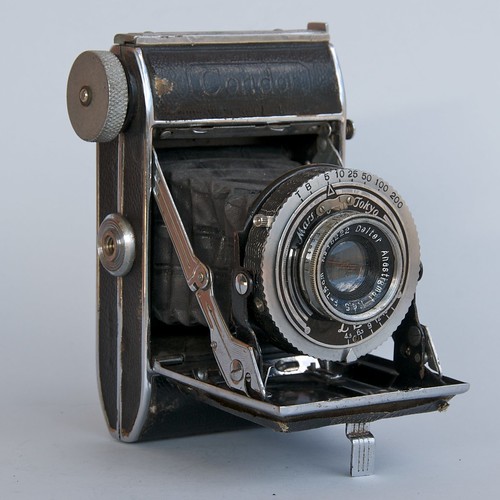
|
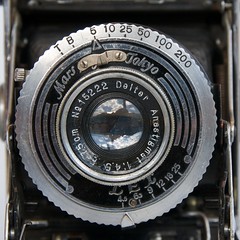
|
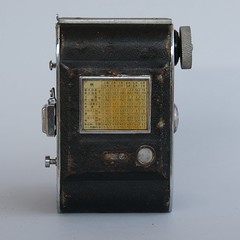
| |
| New Semi Condor, Delter Anastigmat 7.5cm f/3.5 lens no.15222, Lex shutter (B, T, 5–200). Pictures by Dirk HR Spennemann. (Image rights) | |
An example fitted with a filmcounter till 13. Very unusual as the standard number of 6x6 images on a 120 type rollfilm is 12.
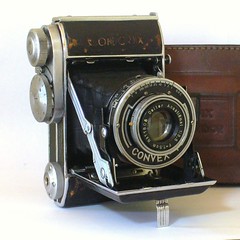 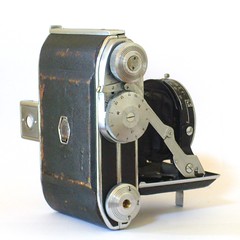 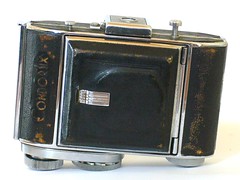
|
| Motodori Shashin Kikai Kōgyō-sho Condor Six, Convex shutter, Delter Anastigmat f3.5/7.5cm lens. Filmcounter till 13 Images by yalluflex. (Image rights) |
Leather cases for the Condor folders have been observed with the name embossed at the front as CONDOR or SEMI CONDOR.[23] The original box has a plain dark colour, with the name SEMI CONDOR inscribed in silver letters.[24]
Notes
- ↑ Date: advertisements and articles listed in Kokusan kamera no rekishi, pp.336–7. Attribution to Motodori: "Kamera no kōtei kakaku kanpō happyō", November 1941. McKeown attributes a "New Semi Condor" to "Nissan Kogaku" (p.738), a company whose relationship to Motodori is unclear, and a "Condor" folder to Neumann & Heilemann (p.717), the latter because of a confusion with the maker of the shutter.
- ↑ Kokusan kamera no rekishi, pp.336–7.
- ↑ Advertisements reproduced in Kokusan kamera no rekishi, p.73.
- ↑ Advertisement published in Asahi Camera, reproduced in Kokusan kamera no rekishi, p.72.
- ↑ Advertisement on p.15 of Nihon Shashin Kōgyō Tsūshin, December 15, 1939, reproduced on p.49 of Hyaku-gō goto jūkai no kiroku.
- ↑ Advertisement on p.22 of Nihon Shashin Kōgyō Tsūshin, December 15, 1939, reproduced on p.56 of Hyaku-gō goto jūkai no kiroku.
- ↑ Advertisement published in Asahi Camera, reproduced in Kokusan kamera no rekishi, p.73.
- ↑ Advertisements reproduced in Kokusan kamera no rekishi, p.72.
- ↑ Date: advertisements listed in Kokusan kamera no rekishi, p.337.
- ↑ Advertisements published in Asahi Camera, reproduced in Kokusan kamera no rekishi, p.72.
- ↑ "Kokusan shashinki no kōtei kakaku", type 3, sections 4A, 5A, 6A, 7A, 7B; type 4, sections 3, 5A, 5B, 6A, 6B.
- ↑ Advertisement published in Shashin Bunka, reproduced in Kokusan kamera no rekishi, p.72.
- ↑ "Kamera no kōtei kakaku kanpō happyō", November 1941, type 3, sections 4A, 5A, 6A, 7A, 7B.
- ↑ Advertisement published in Hōdō Shashin, reproduced in Kokusan kamera no rekishi, p.73.
- ↑ The shutter is only called "A shutter" in the advertisement, but the picture shows a Rulex.
- ↑ "Kokusan shashinki no genjōchōsa" ("Inquiry into Japanese cameras"), item 54, lens item Lb2, shutter item 24-Q-2.
- ↑ Example observed in an online auction.
- ↑ Example observed in an online auction.
- ↑ Sugiyama, item 1036. The lens name is misspelt "Deltar" in the description, but the lens engraving itself reads Delter.
- ↑ Example observed in an online auction.
- ↑ Lens and shutter observed in an online auction.
- ↑ Photographica Collection Dirk Spennemann
- ↑ Cases observed in online auctions.
- ↑ Box observed in an online auction.
Bibliography
Original documents
- "Kamera no kōtei kakaku kanpō happyō" (カメラの公定価格官報発表, Official announcement of the set prices of the cameras), November 1941. Extract of a table listing Japanese camera production and setting the retail prices, reproduced in "Bebī Semi Fāsuto 'Kore ha bebī wo nanotta semi-ki da'" (ベビーセミファースト"これはベビーを名乗ったセミ機だ", Baby Semi First, 'this is a Semi camera called Baby'), an article by Furukawa Yasuo (古川保男) in Camera Collectors' News no. 277 (July 2000). Nishinomiya: Camera Collectors News-sha. P. 27. Type 3, sections 4A, 5A, 6A, 7A, 7B.
- "Kokusan shashinki no genjōchōsa" (国産写真機ノ現状調査, Inquiry into Japanese cameras), listing Japanese camera production as of April 1943. Reproduced in Supuringu kamera de ikou: Zen 69 kishu no shōkai to tsukaikata (スプリングカメラでいこう: 全69機種の紹介と使い方, Let's try spring cameras: Presentation and use of 69 machines). Tokyo: Shashinkogyo Syuppan-sha, 2004. ISBN 4-87956-072-3. Pp.180–7. Item 54.
- "Kokusan shashinki no kōtei kakaku" (国産写真機の公定価格, Set prices of the Japanese cameras), listing Japanese camera production as of October 25, 1940 and setting the retail prices from December 10, 1940. Published in Asahi Camera January 1941 and reproduced in Shōwa 10—40nen kōkoku ni miru kokusan kamera no rekishi (昭和10〜40年広告にみる国産カメラの歴史, Japanese camera history as seen in advertisements, 1935—1965). Tokyo: Asahi Shinbunsha, 1994. ISBN 4-02-330312-7. Pp.108—9. Type 3, sections 4A, 5A, 6A, 7A, 7B; type 4, sections 3, 5A, 5B, 6A, 6B.
- Nihon Shashin Kōgyō Tsūshin (日本写真興業通信). Hyaku-gō goto jūkai no kiroku (百号ごと十回の記録, Ten records, every hundred issues). Tokyo: Nihon Shashin Kōgyō Tsūshin Sha (日本写真興業通信社), 1967. No ISBN number. Advertisements on pp.49 and 56, corresponding to pp.15 and 22 of the December 15, 1939 issue.
Recent sources
- Asahi Camera (アサヒカメラ) editorial staff. Shōwa 10–40nen kōkoku ni miru kokusan kamera no rekishi (昭和10–40年広告にみる国産カメラの歴史, Japanese camera history as seen in advertisements, 1935–1965). Tokyo: Asahi Shinbunsha, 1994. ISBN 4-02-330312-7. Items 112–6. (See also the advertisement for item 118.)
- McKeown, James M. and Joan C. McKeown's Price Guide to Antique and Classic Cameras, 12th Edition, 2005-2006. USA, Centennial Photo Service, 2004. ISBN 0-931838-40-1 (hardcover). ISBN 0-931838-41-X (softcover). Pp.717 and 738.
- Sugiyama, Kōichi (杉山浩一); Naoi, Hiroaki (直井浩明); Bullock, John R. The Collector's Guide to Japanese Cameras. 国産カメラ図鑑 (Kokusan kamera zukan). Tokyo: Asahi Sonorama, 1985. ISBN 4-257-03187-5. Item 1036.